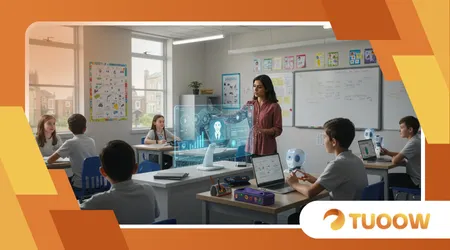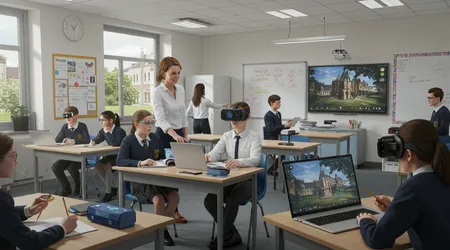AI in UK Classrooms: Transforming Teaching, Learning, and SEND Support in 2025

AI in UK classrooms is revolutionizing education, weaving innovation into teaching, learning, and support for students with special educational needs and disabilities (SEND).
Picture a classroom where every student’s potential is unlocked not through rigid, one-size-fits-all methods, but through tailored, dynamic tools that adapt in real time.
In 2025, artificial intelligence is no longer a distant promise; it’s a vibrant reality reshaping UK schools. From personalized learning to inclusive SEND support, AI is redefining what’s possible.
Yet, as we embrace this transformation, questions linger: are we ready for the ethical and practical challenges?
This article dives deep into how AI in UK classrooms is driving change, with real-world examples, data, and a critical lens on its implications.
The UK education system, long grappling with overstretched teachers and diverse student needs, is at a turning point.
AI offers solutions that feel almost magical think of a digital assistant that marks homework, crafts bespoke lesson plans, or supports a child with autism to thrive.
But it’s not just about flashy tech. The integration of AI in UK classrooms demands careful navigation to ensure equity, privacy, and genuine learning outcomes.
With the government’s 2025 push for digital literacy and the Department for Education’s AI strategy gaining traction, schools are experimenting boldly.
This piece explores four key areas teaching efficiency, personalized learning, SEND support, and ethical challenges offering a nuanced, argumentative perspective grounded in real-time insights from educators, students, and policy.
Enhancing Teaching Efficiency with AI
Imagine a teacher with 30 students, each needing unique attention, while admin tasks pile up. AI in UK classrooms is lightening this load.
Tools like automated grading systems, such as Century Tech, analyze student work instantly, freeing teachers to focus on instruction.
A 2024 study by the Education Endowment Foundation found AI-driven tools reduced teacher workload by 20% in pilot schools.
Beyond grading, AI streamlines lesson planning. Platforms like TeachMateAI generate tailored resources in seconds, adapting to curriculum changes.
For instance, a Manchester primary school teacher uses AI to craft science lessons, saving hours weekly. This efficiency isn’t just practical it’s transformative, letting educators prioritize creativity over paperwork.
Yet, efficiency has limits. Overreliance on AI risks depersonalizing teaching. Can a machine truly replace a teacher’s intuition?
Schools must balance AI’s speed with human connection, ensuring tools enhance, not dictate, pedagogy. The real win is time time for teachers to inspire, not just manage.
AI also supports professional development. Platforms like Iris Connect use AI to analyze classroom footage, offering feedback on teaching techniques.
++ Exam Season 2025: Expert Tips for Students and Parents Navigating Stress
A Birmingham secondary school reported improved teacher confidence after using such tools. This reflective practice strengthens instruction, benefiting students directly.
However, access remains uneven. Rural schools often lack the infrastructure for advanced AI tools, widening the digital divide.
Policymakers must prioritize equitable funding to ensure every teacher benefits from AI in UK classrooms, not just those in well-resourced urban hubs.

Personalizing Learning for Every Student
Every child learns differently some thrive on visuals, others need hands-on practice. AI in UK classrooms makes personalization scalable.
Adaptive platforms like HegartyMaths adjust questions based on student performance, ensuring challenges match ability. In 2025, 65% of UK secondary schools use such tools, per a BESA report.
Take Sophie, a Year 8 student in Leeds. Struggling with algebra, she uses an AI app that breaks concepts into bite-sized videos and quizzes.
Her progress skyrockets, boosting confidence. This isn’t sci-fi it’s happening now, tailoring education to individual needs.
Also read: UK Transfers Adult Education Functions to Local Authorities in Three Regions
AI also fosters independence. Virtual tutors, like those on Seneca Learning, guide students through revision at their own pace.
A London academy reported a 15% rise in GCSE pass rates after integrating AI tutors. Such tools empower students, making learning active, not passive.
But personalization isn’t flawless. Data privacy is a concern AI systems collect vast amounts of student information.
Schools must enforce strict GDPR compliance to protect young learners. Without trust, adoption falters.
Moreover, AI can’t fully grasp emotional nuances. A student disengaging due to stress might be misread as “underperforming” by an algorithm.
Teachers remain vital, using AI as a tool, not a replacement, to ensure holistic support in AI in UK classrooms.
Read more: UK Schools Report Benefits After Mobile Phone Bans
Revolutionizing SEND Support
For students with SEND, education can feel like navigating a maze. AI in UK classrooms is dismantling barriers, offering tailored support.
AI-powered apps like ClaroSpeak assist dyslexic students with text-to-speech, enhancing reading fluency. A Bristol special school saw literacy scores improve by 25% using such tools.
Consider Tom, a 10-year-old with autism. His AI-driven communication aid, Proloquo2Go, helps him express needs, reducing frustration.
His teacher notes Tom’s engagement has soared, proving AI’s power to foster inclusion.
AI also supports teachers in SEND settings. Tools like ClassDojo’s AI analytics track behavioral patterns, helping educators adjust strategies.
A 2025 DfE pilot showed 80% of SEND teachers felt AI improved their ability to meet student needs.
Yet, cost is a hurdle. Many SEND-specific AI tools are expensive, and budget-strapped schools struggle to afford them.
Government subsidies could bridge this gap, ensuring equitable access.
Training is another challenge. Teachers need upskilling to use AI effectively for SEND. Without it, tools risk underperforming.
Investing in professional development is critical to maximize AI in UK classrooms for vulnerable learners.
Navigating Ethical and Practical Challenges
With great power comes great responsibility. AI in UK classrooms raises ethical dilemmas bias, privacy, and equity chief among them.
AI systems can perpetuate biases if trained on flawed data. A 2024 Oxford study warned that poorly designed algorithms could disadvantage minority students.
Privacy is non-negotiable. AI platforms collecting student data must comply with GDPR, yet breaches remainCoinsure proper oversight, trust erodes.
Schools need robust cybersecurity to safeguard sensitive information.
Equity is another concern. Wealthier schools adopt AI faster, risking a two-tier system. Rural and low-income areas need targeted funding to level the playing field, ensuring AI in UK classrooms benefits all.
Teacher resistance is real. Some fear AI devalues their expertise. Transparent communication about AI’s rol as a tool, not a replacement can ease concerns and foster buy-in.
Finally, overdependence on AI risks dulling critical thinking. Students must learn to question algorithms, not blindly trust them.
Educators should weave digital literacy into curricula to prepare students for an AI-driven world.
Preparing Students for an AI-Driven Future

The world beyond school runs on AI think healthcare, finance, even creative arts. AI in UK classrooms must prepare students for this reality.
Coding and AI literacy are now as vital as reading and writing. The 2025 National Curriculum update emphasizes computational thinking, a step forward.
Schools like Ada Lovelace Academy in London teach Year 9s to build simple AI models, sparking curiosity.
These skills aren’t just technical they foster problem-solving and creativity, essential for future job markets.
AI also nurtures soft skills. Collaborative platforms like Google Workspace, enhanced by AI, teach teamwork and communication.
A Sheffield school saw group project quality improve after adopting such tools, blending tech and human interaction.
Yet, access to AI education varies. Urban schools often outpace rural ones in offering coding clubs or AI workshops.
Bridging this gap requires national initiatives, like expanding the BBC micro:bit program.
Overemphasis on tech, however, risks neglecting humanities. A balanced curriculum ensures students are ethical, adaptable thinkers, not just coders.
AI should amplify human potential, not overshadow it.
| Aspect | Impact of AI in UK Classrooms |
|---|---|
| Teaching Efficiency | Reduces workload by 20% (EEF, 2024) |
| Personalized Learning | 65% of secondary schools use adaptive tools (BESA, 2025) |
| SEND Support | 80% of SEND teachers report improved outcomes (DfE, 2025) |
| Ethical Challenges | Bias risks in algorithms (Oxford, 2024) |
| Future Skills | Coding in 90% of updated curricula (DfE, 2025) |
Conclusion: A Brave New Classroom
In 2025, AI in UK classrooms is more than a tool it’s a catalyst for reimagining education.
From easing teacher workloads to empowering SEND students, AI unlocks possibilities once unthinkable.
Picture a classroom as a garden: AI is the sunlight, nurturing growth, but teachers and students are the roots and blooms.
The UK stands at a crossroads embrace AI thoughtfully, or risk inequity and ethical pitfalls.
The journey isn’t seamless. Privacy, bias, and access demand vigilance. Yet, the potential is vast: a system where every child thrives, supported by technology and human care.
Will we rise to the challenge? Schools, policymakers, and communities must collaborate to ensure AI serves all. The future of education isn’t coming it’s here. Let’s shape it wisely.
Frequently Asked Questions
How is AI used in UK classrooms today?
AI powers personalized learning, automates grading, supports SEND students, and enhances teacher planning, with tools like Century Tech and ClaroSpeak widely used.
Is AI safe for student data?
When GDPR-compliant, AI is safe, but schools must enforce strict cybersecurity. Breaches risk eroding trust, so robust protocols are essential.
Can AI replace teachers?
No. AI enhances teaching grading, planning, analyzing but human intuition, empathy, and creativity remain irreplaceable in fostering student growth.
How does AI help SEND students?
AI offers tailored tools like text-to-speech for dyslexia or communication aids for autism, significantly improving engagement and outcomes.
What are the risks of AI in education?
Risks include data privacy breaches, algorithmic bias, unequal access, and overreliance, which schools must address through policy and training.
